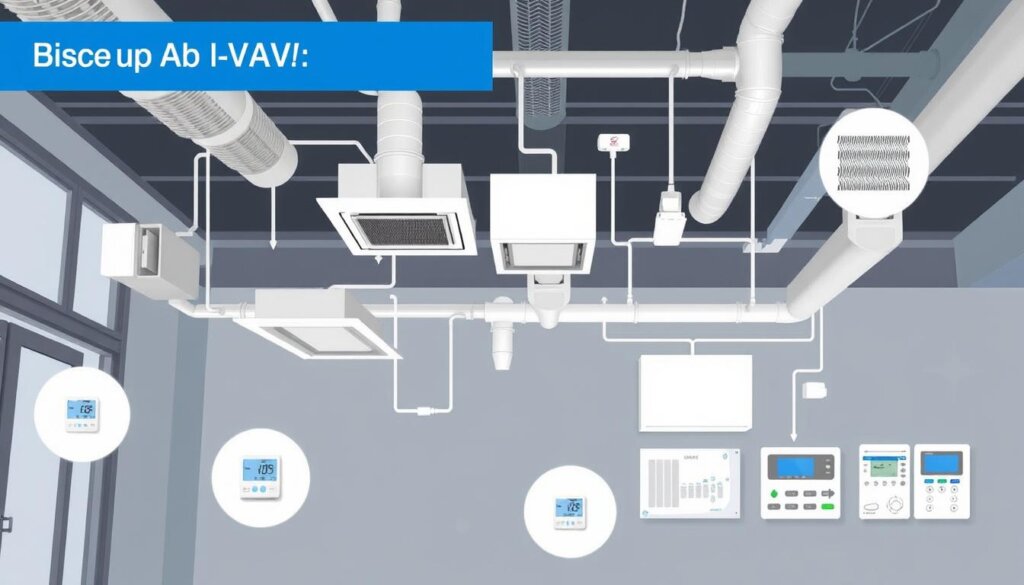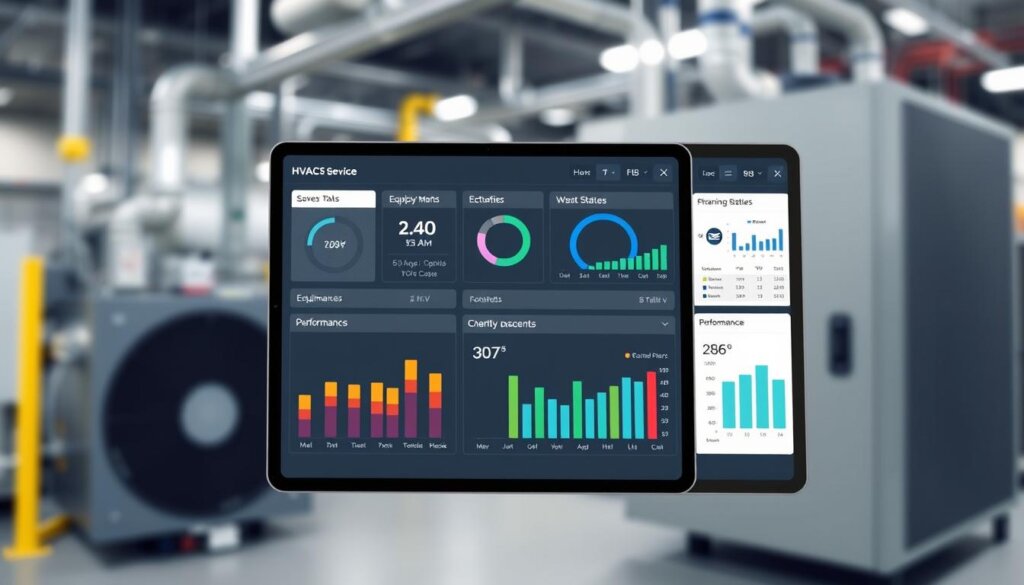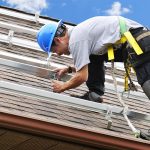Every morning, I step into my office and feel cool air from the Variable Air Volume (VAV) system. It’s not just about comfort; it’s about our productivity too. Recently, I noticed the air changed with the season’s warmth.
This made me realize how important HVAC maintenance is. It’s not just about setting it and forgetting it. Regular maintenance means keeping it clean, testing it, and using the right software to track it. I learned that keeping the perfect temperature can also save money on energy bills.
Key Takeaways
- Perform HVAC preventive maintenance inspections quarterly or bi-annually.
- Regularly clean and replace filters every 30-90 days to reduce energy costs.
- Inspect refrigerant lines at least once a month for optimal performance.
- Use HVAC service software to track maintenance schedules and equipment performance.
- Complete HVAC inspection reports to ensure all key components are functioning properly.
Understanding Your VAV System
A Variable Air Volume (VAV) system helps save energy and control temperatures in buildings. It’s important to know how these systems work and their parts. VAV systems adjust air flow, not keep it constant, for better temperature control in different areas.
The main parts of VAV systems are air handling units and ducts. They make sure air gets to the right places. Balancing dampers are key for fine-tuning air flow, saving energy.
Calibrating VAV boxes is crucial for the best air flow and energy savings. This detail work cuts down on maintenance and repair costs. The right size of VAV systems also means better efficiency and less wear.
Energy efficiency is a big deal for people, and VAV systems are a good choice. They adjust to changing needs and keep air quality high. This makes clients happy, especially in places that need specific temperatures and humidity.
Importance of Regular Maintenance
Regular maintenance is key to making my VAV system work better and last longer. It shows how keeping up with maintenance can make my HVAC system more efficient. This means I pay less for energy over time.
Keeping my VAV system in good shape also makes the air inside healthier. This is important because bad air inside can make people sick more often. Sick leave can go up if the air quality is poor.
It’s very important to take care of my VAV system. Regular checks and cleanings stop small problems from getting bigger. This saves money and makes my system last longer.
Using HVAC service software makes it easier to schedule maintenance. This way, I can keep my system running smoothly without a lot of downtime.
Key Components of a VAV System
Knowing the main parts of a VAV system is key for good maintenance and use. Variable air volume boxes adjust air flow for each area in a building. These components of VAV systems help control temperature, making spaces more comfortable and saving energy.
Diffusers and dampers are crucial in a VAV system. They spread air across different zones. Diffusers make sure air is evenly distributed, while dampers control air flow. This balance is important for consistent temperatures in all areas.
The control system is the heart of the system, watching over indoor conditions and making adjustments as needed. An effective HVAC component overview shows that setting VAV boxes right is key to avoid wasting energy. Also, placing thermostats wisely helps keep temperatures just right.
A well-kept VAV system works efficiently, benefiting both people in the building and HVAC experts. By knowing each VAV system part, I can spot problems during maintenance and keep the system running smoothly for a long time.

Signs Your VAV System Needs Attention
Spotting problems with my VAV system early can prevent expensive fixes and keep it running smoothly. I watch for inconsistent temperatures in different spots. This could mean the system is having trouble balancing the heat or coolness.
Strange sounds from the system usually point to mechanical issues. Also, if the air quality seems off, it might mean the system isn’t moving air well. And, if I see leaks around the ducts, it’s a sign of big energy losses.
Knowing these VAV system alerts helps me fix problems fast. This way, my system stays reliable, keeping everyone comfortable and saving energy.
Essential Maintenance Tasks
Keeping a VAV system in top shape requires several important tasks. These tasks help the system work better and last longer. They also improve the air quality inside and save energy. Here are the main maintenance steps you should follow.
Cleaning and Replacing Filters
Changing filters regularly is key to VAV system care. Dirty filters can block airflow, making the system less efficient and the air quality worse. It’s best to check filters every month and replace them every three months. This keeps the air flowing well and the system working right.
Inspecting Ductwork and Dampers
Duct inspection is crucial to find and fix any problems. I look for damage, dirt, or blockages in the ducts. Also, I make sure dampers work right to control air flow. Regular checks save money and make the system more efficient.
Checking the Control System
It’s important to check the control system too. This system controls airflow and temperature for comfort. I check if sensors and controls are working right and adjust them if needed. Regular checks help the system run smoothly.
Using HVAC Service Software for Maintenance
Using HVAC service software has changed how I manage my VAV system’s maintenance. It makes tracking tasks, scheduling repairs, and checking inventory easier. This tool helps me keep my system in top shape.
HVAC software does more than just organize things. It helps me talk clearly with HVAC technicians, so we can fix problems fast. I can also set reminders for maintenance, which stops problems before they start. This keeps my system running smoothly and for longer.

With the right HVAC service software, managing maintenance is a breeze. It keeps me updated on maintenance history and upcoming tasks. Plus, it makes scheduling repairs easy, which keeps my system running well. Using this technology saves me money and makes my system more efficient.
Benefits of HVAC Service Management Systems
Switching to a better maintenance plan can really boost your VAV system’s performance. HVAC service management systems offer big advantages. They make things run smoother and work better overall.
Organizing Schedule with HVAC Scheduling Software
With HVAC scheduling software, maintenance gets easier. I can set reminders for when it’s time for service. This way, I never forget to keep my VAV system in top shape.
It also means my system lasts longer and uses less energy. Plus, I can keep track of everything easily. It’s all about making maintenance simple and efficient.
Tracking Repairs with HVAC Service Technician Software
Repair tracking software is key for keeping an eye on service history and how technicians do. It lets me keep detailed records of all repairs. This helps me make sure repairs are done right and on time.
Having all this data helps me make better choices. It leads to better service quality. Using these systems makes my VAV system work better and more reliably.
Common Mistakes in VAV System Maintenance
Working on VAV system maintenance needs careful attention. Yet, many common mistakes can harm its performance. One big mistake is ignoring the need to replace filters on time. Dirty filters can block airflow, making systems work too hard and use more energy.
Another mistake is not checking ducts regularly. Ducts can fill up with dust and debris over time. This can lead to big HVAC service errors without anyone noticing. Keeping ducts clean and sealed is key to avoiding problems later on.
Setting control settings incorrectly is another common error. Wrong settings can make the system run inefficiently and make people uncomfortable. It’s important to know how to adjust and keep these controls right to avoid avoiding maintenance mistakes that affect comfort and energy use.
Conclusion
Keeping my VAV system in good shape is key to its efficiency and longevity. I’ve learned that regular maintenance is vital. This includes cleaning filters, checking ductwork, and inspecting control systems.
These steps are essential for a working HVAC system. They help avoid expensive repairs and keep my space comfortable.
I’ve also seen how important HVAC software is. It makes maintenance easier by organizing schedules and tracking repairs. Using this technology helps my system run better and makes maintenance simpler.
Being proactive with VAV maintenance prevents unexpected problems. It also boosts my HVAC system’s performance. By avoiding mistakes and sticking to regular servicing, I get a reliable and efficient space. This shows the value of a solid maintenance plan.
See how FieldAx can transform your Field Operations.
Try it today! Book Demo
You are one click away from your customized FieldAx Demo!
FAQ
What is a Variable Air Volume (VAV) system?
A Variable Air Volume (VAV) system controls air flow and temperature in buildings. It adjusts air volume to different zones. This improves comfort and saves energy.
How can I improve the efficiency of my VAV system?
To boost your VAV system’s efficiency, follow regular maintenance. Use HVAC service software for scheduling and tracking. Make sure all parts work well.
What are the key components of a VAV system?
A VAV system has air handling units, variable air volume boxes, and diffusers. It also includes dampers and a control system. These parts are crucial for managing air flow and comfort.
How often should I perform maintenance on my VAV system?
Maintenance should be done at least twice a year. But, more frequent checks might be needed based on usage and environment.
What signs indicate my VAV system needs maintenance?
Look out for inconsistent temperatures, strange noises, poor air quality, or visible leaks. These signs mean your system needs attention.
What maintenance tasks are essential for my VAV system?
Key tasks include cleaning and replacing filters, and checking ductwork and dampers. Also, ensure the control system is working right.
How can HVAC service software assist with VAV maintenance?
HVAC service software helps with tracking, scheduling, and inventory management. It makes maintenance easier and improves communication with technicians.
What are the benefits of using HVAC service management systems?
HVAC service management systems offer organized scheduling and repair tracking. They also enhance maintenance efficiency.
What common mistakes should I avoid during VAV system maintenance?
Avoid neglecting filter changes, overlooking duct inspections, and mismanaging control settings. These mistakes can reduce efficiency and cause costly repairs.
Author Bio
Co-Founder & CMO at Merfantz Technologies Pvt Ltd | Marketing Manager for FieldAx Field Service Software | Salesforce All-Star Ranger and Community Contributor | Salesforce Content Creation for Knowledge Sharing






